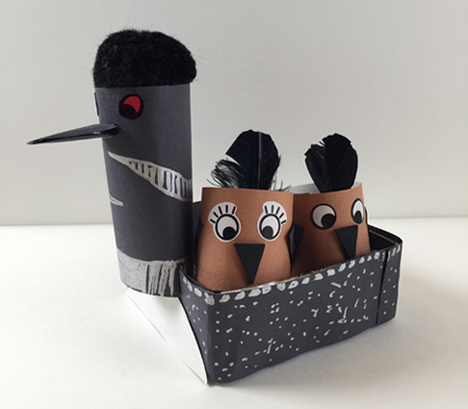
Is there anything more beautiful then the sound of a loon calling? How about the fact that they carry their chicks on their backs when the little ones need a rest? Katie captured the loon love in this simple story time project AND provided the extra bonus at the end of the post!
We recommend reading Little Loon and Papa, written by Toni Buzzeo, and illustrated by Margaret Spengler (Dial Books for Young Readers, 2004 – read aloud here by Hannibal Ferret Story Books). Papa Loon is trying to teach reluctant Little Loon how to dive under the water. When Papa disappears below the water’s surface, Little Loon swim away and gets lost. After bumping into several different animals, Little Loon hears Papa’s call and summons the courage to dive and reunite with his dad!
You’ll need:
- 1 small tissue box
- 2 toilet paper tubes
- Black, white, and brown paper
- Scissors, glue or tape for construction
- Markers for decorating
Common loons are easily recognizable by the unique markings on their feathers and their striking red eyes. They also have extremely identifiable calls, which you can often hear as background outdoor sound bites in TV shows and movies. And as you see here, adult loons will carry their young chicks on their backs to give the babies a break from swimming or to protect them from predators. Just AWWWWW!

Image courtesy of Wikicommons
To make the adult loon, cut a small tissue box down to approximately 1.5″ tall. Cover the box and a toilet paper tube with black paper. Snip 1/4″ slits into the sides of of the toilet paper tube, then slide it onto the box. For the feathers, you can use patterned and silver markers like Katie did, or just go with white paper. The beak is construction paper, as are the eyes (which you should definitely color in red!). The black pompom for the top of the head is optional.
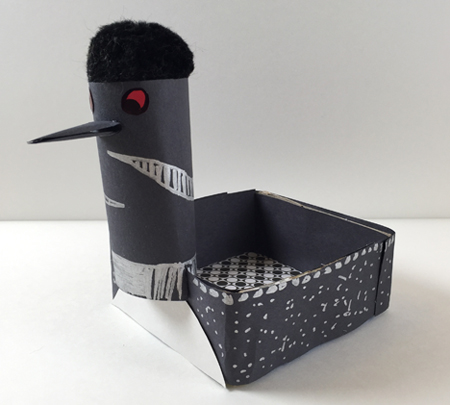
To make the loon chicks, cut a toilet paper tube in half, then wrap each section with brown paper. Add paper wings, beaks, and eyes – or simply use markers to add these features. Feather crests are an option as well! Place the finished chicks onto the back of the adult loon, and marvel in the cuteness!
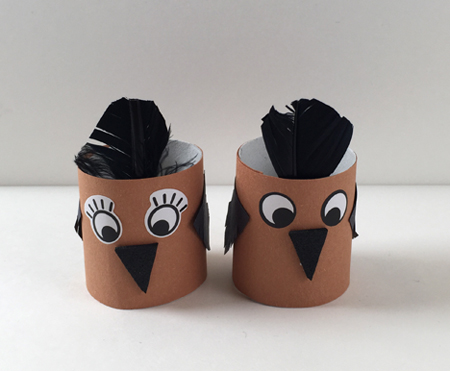
The inspiration for this project was an actual pair of loons, lovingly nicknamed Benny and Joon, who reside together on a lake in northern Wisconsin. Katie and her extended family vacationed on the lake this summer, and were treated to daily visits and concerts by Benny and Joon. Listening to the haunting call of the loons was one of the highlights of their trip, along with tubing, waterskiing and catching plenty of fish!
Ready for 30 seconds of total relaxation with Benny, Joon, and gentle, lapping water?

 This paper disappears in water before your very eyes, leaving the letters floating free. It’s the ultimate aqueous word scramble!
This paper disappears in water before your very eyes, leaving the letters floating free. It’s the ultimate aqueous word scramble!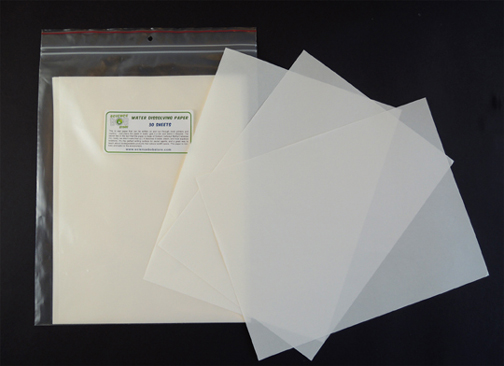 The paper is about half the thickness of standard office printer paper, but it went through both of our office printers and the copy machine with no tearing or jamming. Granted, I was just printing 1 sheet at a time. I did try 3 pages in a row on our most trustworthy office printer. Unfortunately, it had trouble grabbing the thin paper and actually missed the final sheet of the print job entirely. I was waaaay too chicken to try multiple sheets in the copy machine.
The paper is about half the thickness of standard office printer paper, but it went through both of our office printers and the copy machine with no tearing or jamming. Granted, I was just printing 1 sheet at a time. I did try 3 pages in a row on our most trustworthy office printer. Unfortunately, it had trouble grabbing the thin paper and actually missed the final sheet of the print job entirely. I was waaaay too chicken to try multiple sheets in the copy machine.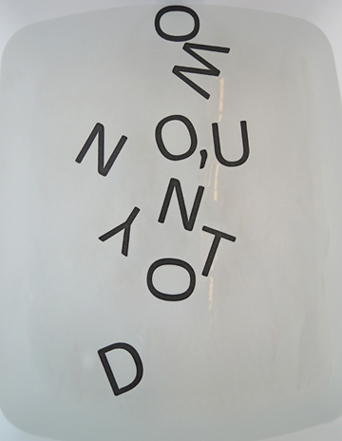 Second test, copy machine. The letters printed considerably lighter on the page (this was a toner thing with our copier, not the paper). But that didn’t impair the letters from floating on the water like little alphabet ducks!
Second test, copy machine. The letters printed considerably lighter on the page (this was a toner thing with our copier, not the paper). But that didn’t impair the letters from floating on the water like little alphabet ducks!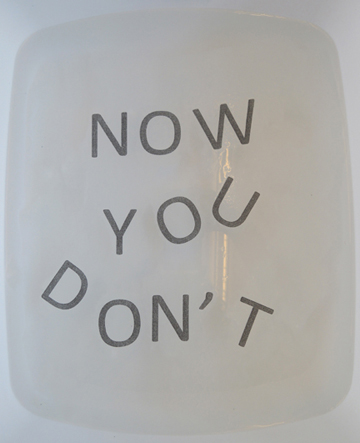 So our laser jet printer and the copy machine worked. What didn’t work? Our inkjet printer. First of all, it blotted the paper during printing…
So our laser jet printer and the copy machine worked. What didn’t work? Our inkjet printer. First of all, it blotted the paper during printing…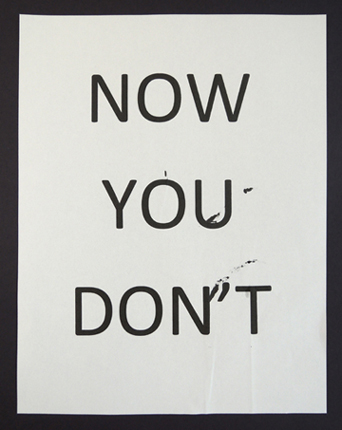 And when it came to the water test, the letters just disintegrated:
And when it came to the water test, the letters just disintegrated: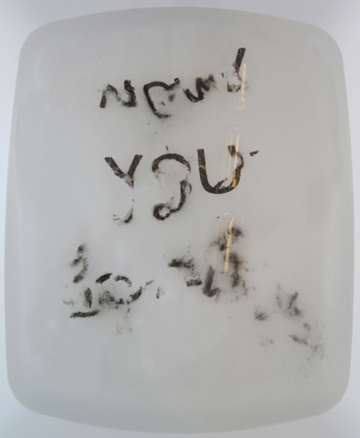 The same applies for Sharpie permanent marker:
The same applies for Sharpie permanent marker: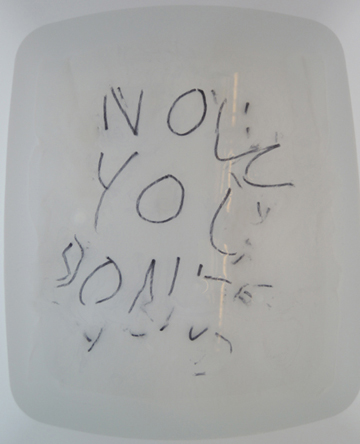 Roller ball ink and ballpoint ink also broke apart. The ballpoint ink shredded immediately (you can just see the sentence “Will ballpoint pen work?” at the bottom of the image below). Roller ball, I am surprised to report, held out a little longer.
Roller ball ink and ballpoint ink also broke apart. The ballpoint ink shredded immediately (you can just see the sentence “Will ballpoint pen work?” at the bottom of the image below). Roller ball, I am surprised to report, held out a little longer. It was sort of cool. The roller ball ink blurred, sunk a little, and then just hung in the water. Eventually, however, the roller ball ink went the way of the ball point, Sharpie, and inkjet. It dissolved into a black smudgy mess.
It was sort of cool. The roller ball ink blurred, sunk a little, and then just hung in the water. Eventually, however, the roller ball ink went the way of the ball point, Sharpie, and inkjet. It dissolved into a black smudgy mess.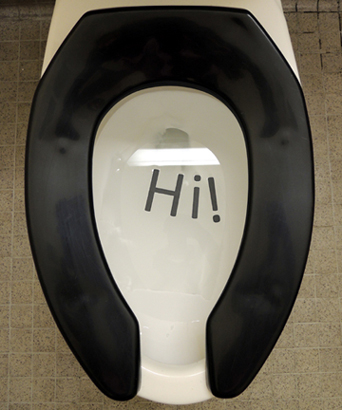 But no matter where you’re dissolving this paper – a dish tub or a commode – the letters do float apart very quickly. So leaving a secret message for someone isn’t really going to work (unless they’re standing right next to you and reading quickly). But this would be a fantastic way to introduce the concept of the anagram. Or jump-start a discussion about biodegradable materials. Or, just experience the fun of watching a sentence you’ve written slide apart and swirl across the surface of the water. Magic!
But no matter where you’re dissolving this paper – a dish tub or a commode – the letters do float apart very quickly. So leaving a secret message for someone isn’t really going to work (unless they’re standing right next to you and reading quickly). But this would be a fantastic way to introduce the concept of the anagram. Or jump-start a discussion about biodegradable materials. Or, just experience the fun of watching a sentence you’ve written slide apart and swirl across the surface of the water. Magic!